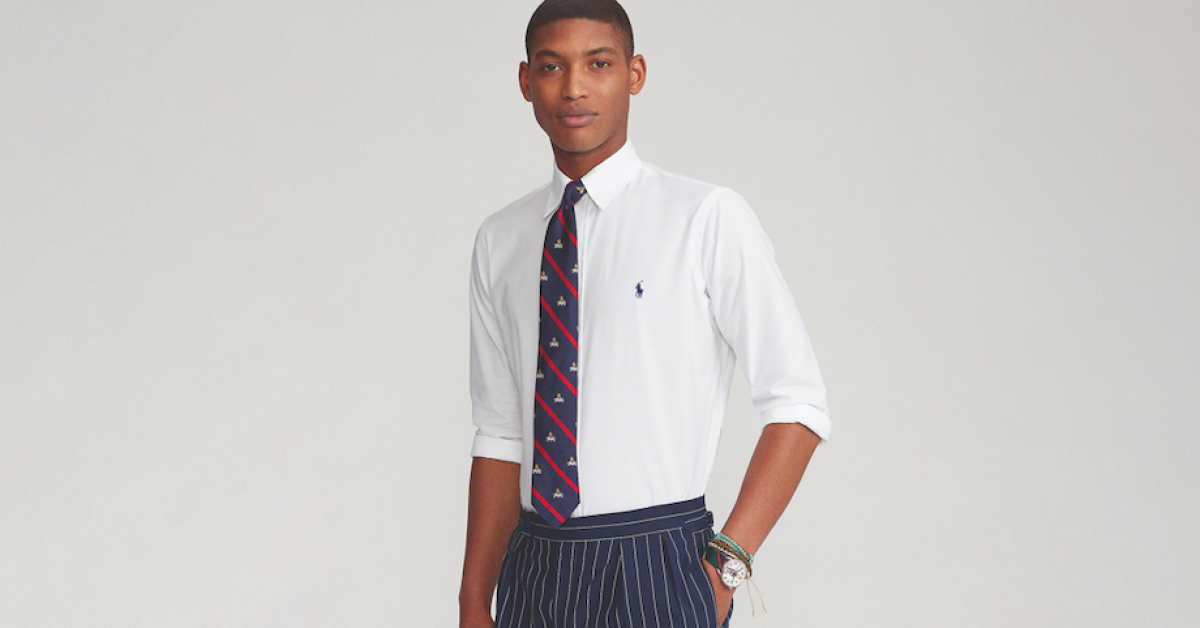For a few hundred years, men’s white shirts—adorned with elaborate ruffles and stiff white, starch-dominated collars—were a status symbol of wealth and influence. But as the 20th century approached, the frill was gone. Wearing a white shirt became more commonplace for the everyman.
Still classic and sometimes worn with external collars, the staple of men’s attire morphed into clothing defined as practical and versatile. Whether worn with a custom-made suit or jeans, a white shirt, like a blue blazer or gray flannel pants, is a quintessential men’s wardrobe item. Dress up, shirt tucked. Dress down, shirt untucked.
Today, a white dress shirt still represents the ultimate neutrality in style. But there’s also great variance. What’s the thread count? Does it have a point, pin, spread or button-down collar? Is it made from broadcloth, 100% cotton, poplin or a newer stretchy hybrid mix?
Tradition still has its place, but personal preference rocks.
“White is still very popular, and we’re a younger gentlemen’s store,” says Ed Ibrahim of Men’s Palace in Naples, which caters to customers age 17 to 60. “So, the trend now is a lot going toward slim fit. People are wearing them casually; people are wearing them dressy. White is the No. 1-selling shirt, period.”

Oxford
As the most well-known white shirt style, an Oxford button-down is a Swiss Army knife of men’s attire. Its name derives from Oxford University (other higher learning institutions had their own shirt names). The manufacturing process, a Panama or basket weave of cotton, is highly breathable and was invented in a weaving mill in Scotland.
The universities’ shirts were marketed with the schools’ names for their respective polo teams. The Oxford style caught on because the shirts were simultaneously casual and stylish. The button-down collar began as a way to alleviate the annoyance of flailing collar ends during training or a match. Who needs that?
Today, Oxford shirts are often made from cotton and remain similarly breathable, durable and simply designed. No frills, no ruffles. They’re perfect to wear with suits, khakis and jeans, and with a tie or without, leaving the top button unbuttoned. The oxford button-down dress shirt began as a trend but it’s now considered style. It’s still a “go-to” for many parts of the country, including Southwest Florida.
“Customers request cotton because it breathes,” Ibra- him says. “We’re in Florida, so the lighter the weight, the softer the touch it has, the better it sells.”

Broadcloth
Dressing for the weather is tantamount in many ways to dressing for success. Smooth, flat-looking and minus a weave pattern, a fitted white broadcloth dress shirt—so named because it was originally woven on broad-width looms—defines dressy. It’s ideal for formal occasions, weddings to certain business job interviews.
Broadcloth is often compared to poplin, but it has less texture and is more transparent. Once made primarily made from wool, broadcloth is now more commonly a weave of cotton and polyester, and a popular new option is a nylon-spandex blend including a strong stretchy component. It’s superlight, wrinkles easily and is extraordinarily smooth. Because broadcloth is so thin and elegant-looking, it’s a popular choice for uber-formal occasions. For custom shirt makers, broadcloth is easy to sew.
With their classy appeal, white broadcloth dress shirts come with downsides: The sheerness means broadcloth isn’t ideal for larger-framed dress shirt wearers. And when they’re made from a combination of silk and/or polyester, hand-washing or special laundering is the way to go. Otherwise, the silk dye may bleed.
“It tends to be slim fit; that’s what guys are buying,” says Ron Brodeur, co-owner of upscale Brodeur Carvell Fine Apparel in Fort Myers. “We do a custom business shirt and, obviously, those are all slim fits. And it’s probably a mid-spread collar is what’s the most popular still.”

Poplin
A white poplin lighter cotton or mixed blends men’s shirt works best in the summer months. “Cool, calm and collected” is more easily achieved in a thinner, durable white shirt. A weave of any fiber or blend, with crosswise ribs that typically give a corded surface, also sell well in warm, humid climates.
Named after the now-defunct and thicker fabric “papelaine,” made in Avignon, France, poplin features a ribbed texture, a tightly closed weave and a soft, elegant feel. It was originally used in women’s dresses and in upscale upholstery. With its sheen appearance, poplin has a sophisticated and functional look. In WWII, poplin became popular in uniform design. It allowed soldiers to remain cool in attire that could endure rough elements and please pesky superiors.
Poplin works well for casual business use and formal wear. It also has other advantages: It’s water-resistant and doesn’t stain or wrinkle easily.
Poplin was used for winter attire 500 years or so ago when it was largely made by combining silk and wool. But now as a light cotton blend, poplin is best left in the closet in colder conditions. Regardless of composition, poplin remains made of two yarns of different thicknesses in a plain weave.





